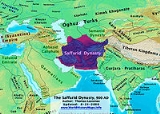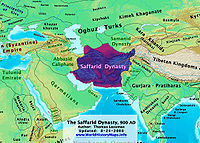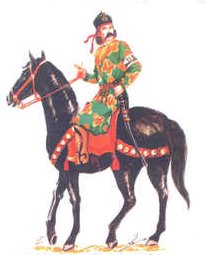
Saffarid dynasty
Encyclopedia


Sistan
Sīstān is a border region in eastern Iran , southwestern Afghanistan and northern tip of Southwestern Pakistan .-Etymology:...
(861-1002), a historical region in southeastern Iran
Iran
Iran , officially the Islamic Republic of Iran , is a country in Southern and Western Asia. The name "Iran" has been in use natively since the Sassanian era and came into use internationally in 1935, before which the country was known to the Western world as Persia...
, southwestern Afghanistan
Afghanistan
Afghanistan , officially the Islamic Republic of Afghanistan, is a landlocked country located in the centre of Asia, forming South Asia, Central Asia and the Middle East. With a population of about 29 million, it has an area of , making it the 42nd most populous and 41st largest nation in the world...
and northwestern Pakistan
Pakistan
Pakistan , officially the Islamic Republic of Pakistan is a sovereign state in South Asia. It has a coastline along the Arabian Sea and the Gulf of Oman in the south and is bordered by Afghanistan and Iran in the west, India in the east and China in the far northeast. In the north, Tajikistan...
. Their capital was Zaranj
Zaranj
Zaranj or Zarang is a border town in south-western Afghanistan, with a population of approximately 49,851 people as of 2004. It is the capital of Nimruz province and is situated next to Milak, Iran. It is linked by highways with Lashkar Gah to the east, Farah to the north and Zabol in Iran to the...
, located in present-day Afghanistan
Afghanistan
Afghanistan , officially the Islamic Republic of Afghanistan, is a landlocked country located in the centre of Asia, forming South Asia, Central Asia and the Middle East. With a population of about 29 million, it has an area of , making it the 42nd most populous and 41st largest nation in the world...
.
The dynasty was founded by – and took its name from – Ya'qub bin Laith as-Saffar
Ya'qub bin Laith as-Saffar
Ya'qub bin Laith as-Saffar or Ya'qub-i Laith Saffari was the founder of the Saffarid dynasty in Sistan, with its capital at Zaranj . He ruled territories that are now in Iran and Afghanistan, as well as portions of West Pakistan...
, a man of humble origins who rose from an obscure beginning as a coppersmith (ṣaffār) to become a warlord. He seized control of the Sistan region, conquering all of Afghanistan, modern-day eastern Iran, and parts of Pakistan
Pakistan
Pakistan , officially the Islamic Republic of Pakistan is a sovereign state in South Asia. It has a coastline along the Arabian Sea and the Gulf of Oman in the south and is bordered by Afghanistan and Iran in the west, India in the east and China in the far northeast. In the north, Tajikistan...
. Using their capital (Zaranj) as base for an aggressive expansion eastwards and westwards, they overthrew the Tahirid dynasty
Tahirid dynasty
The Tahirid Dynasty, was a Persian dynasty that governed from 820 to 872 over the northeastern part of Greater Iran, in the region of Khorasan . The dynasty was founded by Tahir ibn Husayn, a leading general in the service of the Abbasid caliph al-Ma'mun...
and annexed Khorasan
Greater Khorasan
Greater Khorasan or Ancient Khorasan is a historical region of Greater Iran mentioned in sources from Sassanid and Islamic eras which "frequently" had a denotation wider than current three provinces of Khorasan in Iran...
in 873. By the time of Ya'qub's death, he had conquered Kabul Valley
Kabulistan
Kabulistan is a historical term referring to the eastern territories of Greater Khorasan that is centered around present-day Kabul, Afghanistan...
, Sindh
Sindh
Sindh historically referred to as Ba'ab-ul-Islam , is one of the four provinces of Pakistan and historically is home to the Sindhi people. It is also locally known as the "Mehran". Though Muslims form the largest religious group in Sindh, a good number of Christians, Zoroastrians and Hindus can...
, Tocharistan, Makran
Makran
The present day Makran is a semi-desert coastal strip in the south of Sindh, Balochistan, in Iran and Pakistan, along the coast of the Arabian Sea and the Gulf of Oman. The present day Makran derived its name from Maka, a satrap of Achaemenid Empire....
(Balochistan
Balochistan (region)
Balochistan or Baluchistan is an arid, mountainous region in the Iranian plateau in Southwest Asia; it includes part of southeastern Iran, western Pakistan, and southwestern Afghanistan. The area is named after the numerous Baloch tribes, Iranian peoples who moved into the area from the west...
), Kerman
Kerman
- Geological characteristics :For the Iranian paleontologists, Kerman has always been considered a fossil paradise. Finding new dinosaur footprints in 2005 has now revealed new hopes for paleontologists to better understand the history of this area.- Economy :...
, Fars, Khorasan, and nearly reached Baghdad
Baghdad
Baghdad is the capital of Iraq, as well as the coterminous Baghdad Governorate. The population of Baghdad in 2011 is approximately 7,216,040...
but then suffered defeat.
The Saffarid empire did not last long after Ya'qub's death. His brother and successor Amr bin Laith
Amr bin Laith
Amr-i Laith Saffari was the second ruler of the Saffarid dynasty of Iran who ruled .In the beginning he was a mule-hirer. He was Yaqub bin Laith as-Saffar's younger brother who fought alongside his older brother and in 875 became Governor of Herat....
was defeated in a battle against Ismail Samani in 900. Amr bin Laith was forced to surrender most of their territories to the new rulers. The Saffarids were subsequently confined to their heartland of Sistan, with their role reduced to that of vassal
Vassal
A vassal or feudatory is a person who has entered into a mutual obligation to a lord or monarch in the context of the feudal system in medieval Europe. The obligations often included military support and mutual protection, in exchange for certain privileges, usually including the grant of land held...
s of the Samanids and their successors.
Founding
The Saffarid dynasty started with Ya'qub-i Laith Saffari who as a coppersmith moved to the city of ZaranjZaranj
Zaranj or Zarang is a border town in south-western Afghanistan, with a population of approximately 49,851 people as of 2004. It is the capital of Nimruz province and is situated next to Milak, Iran. It is linked by highways with Lashkar Gah to the east, Farah to the north and Zabol in Iran to the...
. He later started his campaign as an Ayyar
Ayyarun
Áyyār, refers to a person associated with a class of warriors in Iraq and Iran from the 9th to the 12th centuries. The word literally means vagabond...
and eventually got the power to act as an independent ruler. From his capital Zaranj he moved east into al-Rukhkhadj and Zamindawar reaching as far as Zunbil and Kabul by 865. He took vast amounts of plunder and slaves from this campaign. The Tahirid
Tahirid dynasty
The Tahirid Dynasty, was a Persian dynasty that governed from 820 to 872 over the northeastern part of Greater Iran, in the region of Khorasan . The dynasty was founded by Tahir ibn Husayn, a leading general in the service of the Abbasid caliph al-Ma'mun...
city of Herat was taken in 870 and his campaign in the Baghghis region led to the capture of Kharidjites which later formed the Djash al-Shurat contingent in his army. Ya'qub then turned his focus to the west and began attacks on Khurasan, Khuzistan, Kirman and Fars. These attacks forced the Abbasid
Abbasid
The Abbasid Caliphate or, more simply, the Abbasids , was the third of the Islamic caliphates. It was ruled by the Abbasid dynasty of caliphs, who built their capital in Baghdad after overthrowing the Umayyad caliphate from all but the al-Andalus region....
caliphate to recognize him as governor of Kirman.
In 901, Amr Saffari was defeated at the battle of Balkh by the Samanids, which reduced the Saffarid dynasty to a minor tributary in Sistan.
In 1002, Mahmud of Ghazni
Mahmud of Ghazni
Mahmud of Ghazni , actually ', was the most prominent ruler of the Ghaznavid dynasty who ruled from 997 until his death in 1030 in the eastern Iranian lands. Mahmud turned the former provincial city of Ghazni into the wealthy capital of an extensive empire which covered most of today's Iran,...
invaded Sistan
Sistan
Sīstān is a border region in eastern Iran , southwestern Afghanistan and northern tip of Southwestern Pakistan .-Etymology:...
, dethroned Khalaf I
Khalaf I
Abu Ahmad Khalaf was the Saffarid amir of Sistan from 963 until 1002. Although he was renowned in the eastern Islamic world as a scholar, his reign was characterized by violence and instability, and Saffarid rule over Sistan came to an end with his deposition.-Early life:Khalaf was born in the...
and ended the Saffarid dynasty.
Culture
The Saffarids gave great care to the Persian culture and under their rule the Eastern Islamic lands witnessed the emergence of prominent Persian poets like Fayrouz Mashriqi, Abu Salik al-Jirjani, and Muhammad bin Wasif al-Sistani.From silver mines in the Panjshir Valley
Panjshir Valley
The Panjshir Province is a valley in north-central Afghanistan, 150 km north of Kabul, near the Hindu Kush mountain range. Located in the Panjshir Province it is divided by the Panjshir River...
, the Saffarids were able to mint silver coins.
Rulers of the Saffarid dynasty
- Ya`qûb ben Layth as-Saffâr (867867Year 867 was a common year starting on Wednesday of the Julian calendar.- Byzantine Empire :* September – Basil I becomes sole ruler of the Byzantine Empire.* Macedonian dynasty is started....
-879879Year 879 was a common year starting on Thursday of the Julian calendar.- Europe :* Pope John VIII recognizes the Duchy of Croatia as an independent state....
) - Amr I (Saffarides) (879879Year 879 was a common year starting on Thursday of the Julian calendar.- Europe :* Pope John VIII recognizes the Duchy of Croatia as an independent state....
-901901Year 901 was a common year starting on Thursday of the Julian calendar.- Africa :* Abu 'Abdullah al-Shi'i leads the rebellion of the Kutama Berbers against the Aghlabid emirate in Ifriqiya ....
) - Tâhir ben Muhammad ben `AmrTahir IAbu'l-Hasan Tahir was amir of the Saffarid amirate from 901 until 909. He was the son of Muhammad b. Amr.In 900 the ruling Saffarid amir, Amr bin Laith, was captured by the Samanids while campaigning against them in Khurasan...
(901901Year 901 was a common year starting on Thursday of the Julian calendar.- Africa :* Abu 'Abdullah al-Shi'i leads the rebellion of the Kutama Berbers against the Aghlabid emirate in Ifriqiya ....
-908908Year 908 was a leap year starting on Friday of the Julian calendar.- Asia :* The Battle of Belach Mugna is fought.* Zhu Wen kills the last Tang Dynasty emperor.- Deaths :* Al-Muktafi, Abbasid caliph...
) - Layth ben `AlîLaithAl-Laith was amir of the Saffarid amirate from 909 until 910. He was the son of 'Ali ibn al-Laith.In 890 al-Laith and his brother al-Mu'addal helped their father 'Ali escape from imprisonment at the hands of the latter's uncle, the Saffarid amir Amr bin Laith...
(908908Year 908 was a leap year starting on Friday of the Julian calendar.- Asia :* The Battle of Belach Mugna is fought.* Zhu Wen kills the last Tang Dynasty emperor.- Deaths :* Al-Muktafi, Abbasid caliph...
-910910Year 910 was a common year starting on Monday of the Julian calendar.- Europe :* August 5 – The allied forces of Mercia and Wessex defeat an army of Northumbrian Vikings in the Battle of Tettenhall...
) - Muhammad ben `AlîMohammed I of PersiaMuhammad ibn 'Ali was amir of the Saffarid amirate from 910 until 911.Early in 910 Muhammad’s brother, the Saffarid amir Al-Laith b. 'Ali, led an army west towards Fars in an effort to wrest it from its ruler, the slave commander Sebük-eri...
(910910Year 910 was a common year starting on Monday of the Julian calendar.- Europe :* August 5 – The allied forces of Mercia and Wessex defeat an army of Northumbrian Vikings in the Battle of Tettenhall...
-912912Year 912 was a leap year starting on Wednesday of the Julian calendar.-Africa:* Second rebellion of the Kutama tribesmen against the Fatimid Caliphate in two years.- Europe :...
) - `Amr bin Ya`qûb ben Muhammad ben `AmrAmr IIAbu Hafs 'Amr was the Saffarid amir of Sistan for slightly over a year . He was the son of Ya'qub, the brother of Tahir I.In 912, opposition to the Samanid governor of Sistan Mansur b. Ishaq resulted in a revolt...
(912912Year 912 was a leap year starting on Wednesday of the Julian calendar.-Africa:* Second rebellion of the Kutama tribesmen against the Fatimid Caliphate in two years.- Europe :...
-913913Year 913 was a common year starting on Friday of the Julian calendar.- Africa :* The Shiite Fatimid state in modern day Tunisia launches a failed military campaign against Egypt.- Religion :...
) - Ahmad ben Muhammed bin Khalaf bin Layth bin `AlîAhmad I bin MohammedAbu Ja'far Ahmad b. Muhammad was the amir of Sistan from 923 until his death. He is responsible for restoring Saffarid rule over Sistan, and was a great patron of the arts.-Ancestors:Abu Ja’far Ahmad’s father was named Muhammad...
(922922Year 922 was a common year starting on Tuesday of the Julian calendar.- Asia :* The Khitan Empire, led by Abaoji, raids Hebei, China.- Deaths :* March 26 – Mansur Al-Hallaj, Sufi writer...
-963963Year 963 was a common year starting on Thursday of the Julian calendar.- Asia :* Turkish Khan Sebük Tigin establishes his empire in modern day Afghanistan....
) - Walî ad-Dawlah Khalaf ben AhmadKhalaf IAbu Ahmad Khalaf was the Saffarid amir of Sistan from 963 until 1002. Although he was renowned in the eastern Islamic world as a scholar, his reign was characterized by violence and instability, and Saffarid rule over Sistan came to an end with his deposition.-Early life:Khalaf was born in the...
(963963Year 963 was a common year starting on Thursday of the Julian calendar.- Asia :* Turkish Khan Sebük Tigin establishes his empire in modern day Afghanistan....
-1002)
See also
- SistanSistanSīstān is a border region in eastern Iran , southwestern Afghanistan and northern tip of Southwestern Pakistan .-Etymology:...
- History of AfghanistanHistory of AfghanistanThe written history of Afghanistan can be traced back to the Achaemenid Empire ca. 500 BCE, although evidence indicates that an advanced degree of urbanized culture has existed in the land since between 3000 and 2000 BCE. Alexander the Great and his Macedonian army arrived to Afghanistan in 330 BCE...
- History of PakistanHistory of PakistanThe 1st known inhabitants of the modern-day Pakistan region are believed to have been the Soanian , who settled in the Soan Valley and Riwat almost 2 million years ago. Over the next several thousand years, the region would develop into various civilizations like Mehrgarh and the Indus Valley...
- History of IranHistory of IranThe history of Iran has been intertwined with the history of a larger historical region, comprising the area from the Danube River in the west to the Indus River and Jaxartes in the east and from the Caucasus, Caspian Sea, and Aral Sea in the north to the Persian Gulf and the Gulf of Oman and Egypt...
- List of kings of Persia
- List of Muslims
- List of Sunni Muslim dynasties

